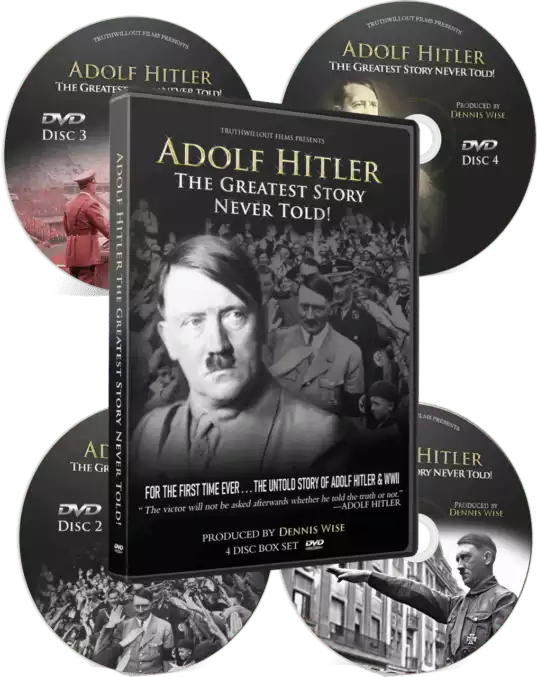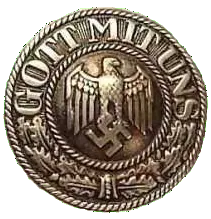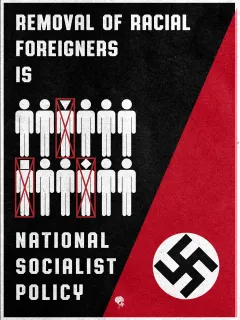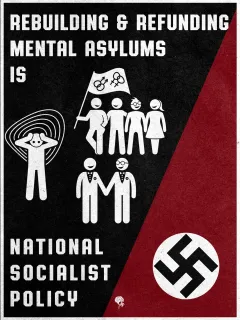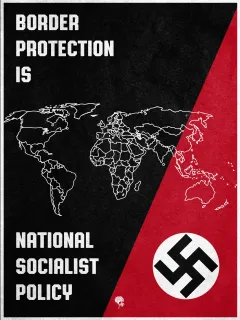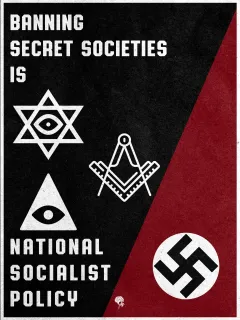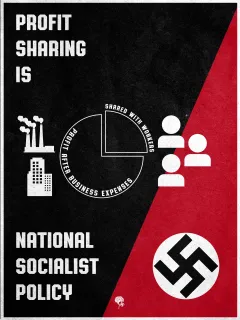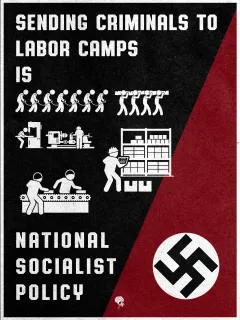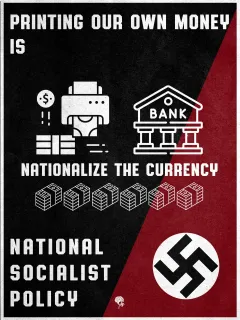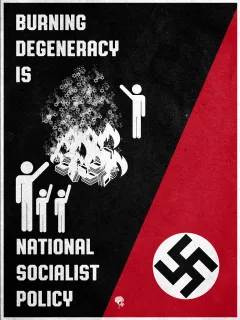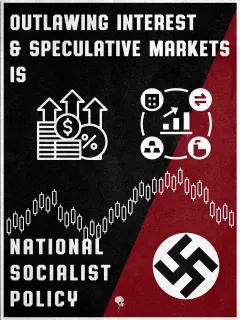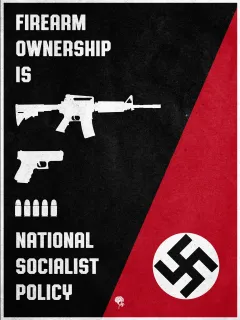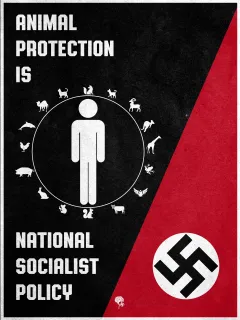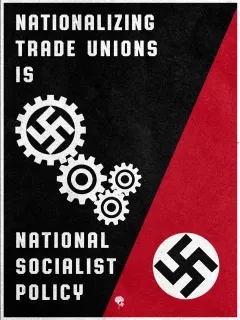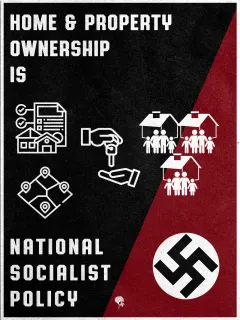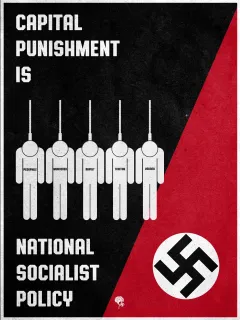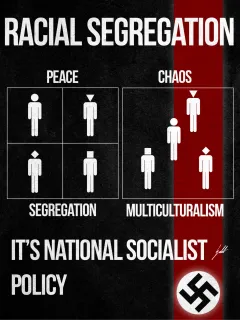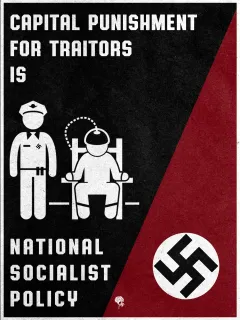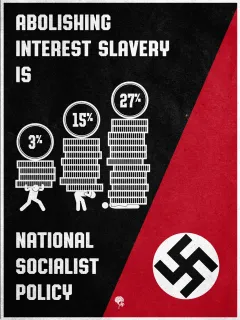The Correct and the Incorrect
THE 'INCORRECT’ SIX MILLION
Alexander Solzhenitsyn, Nobel Prizewinner and author of The Gulag Archipelago, in a speech in Washington in 1975 had this to say of the Soviet system which was deemed worthy of recognition as one of 'our' Allies fighting 'for Democracy' against the 'Dictators' in WW2:
"This was a system which, in time of peace, artificially created a famine causing SIX MILLION PERSONS to die in the Ukraine between 1932 and 1933. They died on the very threshold of Europe. And Europe didn't even notice it. The world didn't even notice it. SIX MILLION PERSONS!"
(Alexander Solzhenitsyn Speaks to the West (1978) p 16)
Who were these people, and why was and is their fate unknown to the ordinary man in the street in western countries?
Franklin Roosevelt’s ally and associate Joseph Stalin was the supreme dictator of Russia for almost a quarter of a century, from 1929 until his death in 1953. Born as Iosif Djugashvili, he adopted the very indicative name 'Stalin', 'man of steel'. He lived up to this name in every respect. Soviet Russia under Stalin was a despotic police state that relied on espionage and terror, with a profound gulf in manner of living between the rulers and the ruled.
Stalin's first Five-Year Plan (1928-1932) sought to bring about the 'collectivization of agriculture' in accordance with the 'abolition of property in land' put forward in Karl Marx's Communist Manifesto. But back in 1861 Czar Alexander II had liberated 23 million serfs, four years before slavery was abolished in the United States. In the period before the Revolution, millions of these peasants had been enabled to get title to their own individual plots, boosting Russian agricultural productivity. These independent peasant farmers became known as kulaks. When Communism was imposed on Russia, the kulaks as private property owners now stood in the way of the idea of Communism. In 1929 Stalin called for 'the liquidation of the kulaks', and their small family farms, animals, implements and crops were declared to belong to the state. "(The Jews) Trotsky, Zinoviev and Kamenev had always argued that the peasant would never surrender enough food voluntarily, and must be coerced and, if need be, crushed" (*Paul Johnson A History of the Modern World (1983) p 268). The Red Army and the GPU secret police were used to implement the policy. All peasants who resisted were treated with violence. A very large number were killed or sent in cattle or freight trains to exile in remote areas in the frozen north or the desert steppes. Rather than give up their animals to the collective farms, many peasants killed and ate them. As a result, the number of farm animals in the Soviet Union was catastrophically reduced:
|
1928 |
1933 |
Cattle |
30,7 million |
19,6 million |
Sheep and goats |
146,7 million |
50,2 million |
Hogs |
26 million |
12,1 million |
Horses |
33,5 million |
16,6 million |
(*Quigley, Tragedy and Hope, p 398).
The peasants stopped farming on ground that suddenly, officially, no longer belonged to them. As a result, food production decreased drastically. After a while, the cities started running out of food. Orders were given for grain to be confiscated from the peasants, whether they had sufficient for themselves and their families or not. Those caught trying to reserve food for their families were ‘severely dealt with’. By the winter of 1932-3, virtually no food was left in the countryside. By early March 1933, 'death on a mass scale really began' (Robert Conquest, The Harvest of Sorrow (1986) p243). The main farming areas of Russia, in the regions of the Ukraine and North Caucasus, were utterly devastated. Millions of people were forced to eat anything that was available, mice, rats, birds, grass, nettles, bark and even cats and dogs, but even then did not survive. It was a time of great and terrible hunger, a catastrophic man-made famine.
The American journalist Eugene Lyons was sent to Russia in 1928 as chief correspondent for the United Press agency. Arriving as an enthusiastic communist, he was able to experience the Soviet experiment at first hand. He became extremely disillusioned. He described the famine in his book Assignment in Utopia (published in 1937) in the following terms:
"Hell broke loose in seventy thousand Russian villages.. A population as large as all of Switzerland's or Denmark's was stripped clean of all their belongings.. They were herded with bayonets at railroad stations, packed indiscriminately into cattle cars and freight cars and dumped weeks later in the lumber regions of the frozen North, the deserts of central Asia, wherever labor was needed, there to live or die..". The number of people that died is unknown, but the famine alone is estimated conservatively to have been responsible for 6 million deaths, almost half of them children (*Conquest, p 303-4). Other millions died from the killings and sickness as a result of the deportations (*p 304-7). At the famous Yalta conference in 1945, Winston Churchill was able to question his friend and fellow ally Stalin about the process. Stalin said 'ten million' had been 'dealt with', but that it had been 'absolutely necessary'. Churchill records that he 'sustained the strong impression of millions of men and women being blotted out or displaced forever' (*Churchill, The Second World War, vol. IV p448). However Churchill – thank God for Winston Churchill - had no further comment to make on the matter. Controlling the agenda is always so important!
Lyons, himself Jewish, credits the Jewish commissar Lazar Kaganovich with the major portion of responsibility for this major crime against humanity:
"Lazar Kaganovich… it was his mind that invented the Political Departments to lead collectivized agriculture, his iron hand that applied Bolshevik mercilessness." (*Lyons, p 578). The Encyclopaedia Britannica says tersely, "(Kaganovich) was one of the small group of Stalin's top advisors pushing for very high rates of collectivization after 1929.. Within the Politburo, Kaganovich and Molotov led the opposition to Kirov's proposed concessions to the peasantry and to his attempts to relax the harshness of Stalin's control.. (Kaganovich) opposed Krushchev's de-Stalinization..". Kaganovich died at the ripe old age of 98 in 1991 (Encl. Brit.), ethnically safe from pursuit by the Israeli secret service, the Simon Wiesenthal organization, the New York media-intelligentsia or other hunters of real or imagined war criminals or human rights violators.
The suffering caused by the great man-made famine was covered by some reports in newspapers in Britain, Europe and the United States. Books dating from before World War Two can still be found in second-hand bookshops which describe the ferocity… Arthur Koestler, Soviet Myth and Reality in The Yogi and the Commissar (1945) Muggeridge, Lyons, Chamberlin… Yet this episode has been completely, entirely, totally ignored by our guardians of history, morality and political correctness…
NO MEMORIAL EXISTS IN WASHINGTON DC
(obviously) to record the indescribable scale of human suffering which resulted, undoubtedly because such a high burden of responsibility for it lies with the Jew Kaganovitch, and because the victims were not Jewish. No chance exists for such a monument, according to a private consensus, owing to certain political realities.
This six million is the ‘incorrect’ six million, because their inconvenient story is not and has not been useful to today’s elite. The tribal affiliations of the chief perpetrator (Jew) and the victims (non-Jews) are the wrong ones, not fitting into the ‘correct’ pattern.
According to Solzhenitsyn in the eighty years that preceded the Revolution in Russia, - years of revolutionary activity, uprisings and the assassination of a Czar, an average of ten persons a year were executed. After the Revolution, in 1918 and 1919, according to the figures of the Cheka, the secret police itself - more than a thousand persons were executed per month without trial. In 1937-8, at the height of Stalin's terror, more than 40 000 persons were executed per month. (*Solzhenitsyn p17).
Millions of persons were executed or sent to labour camps. In his magnum opus The Gulag Archipelago, Solzhenitsyn credits Naftaly Frenkel, a ‘Turkish-born Jew’, with being works chief / chief overseer of the one-hundred-and-forty-mile-long Belomor (Baltic-White Sea) canal, built entirely with slave labour (paperback edition, vol 2 p 72). Solzhenitsyn quotes the official Soviet history of the project which describes Frenkel as having ‘..the eyes of an interrogator and prosecutor.. A man with enormous love of power and pride, for whom the main thing is unlimited power. If it is necessary for him to be feared, then let him be feared. He spoke harshly to the engineers, attempting to humiliate them.’ (ibid p 75). Other Jews were also involved in influential positions. Yakov Rappoport was deputy chief of construction (p 78) and Matvei Berman was the Chief of Gulag (p 79). Frenkel, Berman and Rappoport are amongst six men described by Solzhenitsyn as ‘hired murderers’, ‘each of whom accounted for thirty thousand lives’ (p 91). Is Solzhenitsyn alone in his accusations? Why are these names generally unknown to ordinary citizens in the West?
"The major role Jewish leaders played in the November (Russian) revolution was probably more important than any other factor in confirming (Hitler's) anti-Semitic beliefs." (J&S Pool, Who Financed Hitler, p.164).
"There has been a tendency to circumvent or simply ignore the significant role of Jewish intellectuals in the German Communist Party, and thereby seriously neglect one of the genuine and objective reasons for increased anti-Semitism during and after World War 1.. The prominence of Jews in the revolution and early Weimar Republic is indisputable, and this was a very serious contributing cause for increased anti-Semitism in post-war years.. It is clear then that the stereotype of Jews as socialists and communists.. led many Germans to distrust the Jewish minority as a whole and to brand Jews as enemies of the German nation." (Sarah Gordon Hitler, Germans and the ‘Jewish Question’ Princeton University Press (1984) p 23).
"The second paroxysm of strong anti-Semitism came after the critical role of Jews in International Communism and the Russian Revolution and during the economic crises of the 1920s and 30s… Anti-Semitism intensified throughout Europe and North America following the perceived and actual centrality of Jews in the Russian Revolution.. Such feelings were not restricted to Germany, or to vulgar extremists like the Nazis. All over Northern Europe and North America, anti-Semitism became the norm in 'nice society', and 'nice society' included the universities." (Bernal, Black Athena vol. 1 pp. 367, 387).
"To many outside observers, the Russian revolution looked like a Jewish conspiracy, especially when it was followed by Jewish-led revolutionary outbreaks in much of central Europe. The leadership of the Bolshevik Party had a preponderance of Jews and included Litvinov (real name Wallach), Liadov (Mandelshtam), Shklovsky, Saltz, Gusev (Drabkin), Zemliachka (Salkind), Helena Rozmirovich, Serafima Gopner, Yaroslavsky (Gubelman), Yaklovlev (Epstein), Riaznov (Goldendach), Uritsky and Larin. Of the seven members of the Politburo, the inner cabinet of the country, four, Trotsky (Bronstein), Zinoviev (Radomsky), Kamenev (Rosenfeld) and Sverdlov, were Jews."
When Lenin died in 1924, Zinoviev - the first chairman of the Communist International - formed a triumvirate with Kamenev and Stalin to govern Russia. This 'Troika' as it was known was formed to keep Trotsky from the succession. Stalin was the only one of the three members of the Troika who was not Jewish. "Though Zinoviev and Kamenev feared Trotsky as too militant and extreme, they shared his belief in permanent revolution, which Stalin did not. Russia had been in almost continuous turmoil for twenty years and had suffered revolutions and counter-revolutions, war, invasions and a pitiless and drawn-out civil war. There were limits to which the endurance of a people could be stretched. The Russians wanted to bury their dead and resume what they could of normal life. Stalin understood this. Trotsky, Zinoviev and Kamenev (the three Jews) did not."
"Jews had a prominent role in Communist parties elsewhere.." (Chaim Bermant, The Jews (1977)).
THE ‘CORRECT’ SIX MILLION
What about the ‘Actual’ Holocaust?
Norman G. Finkelstein of the City University of New York says:
‘ "The Holocaust" is an ideological representation of the Nazi holocaust. Like most ideologies, it bears a connection, if tenuous, with reality. The Holocaust is not an arbitrary, but rather an internally coherent construct. Its central dogmas sustain significant political and class interests. Indeed, The Holocaust has proven to be an indispensable ideological weapon. Through its deployment, one of the world’s most formidable military powers, with a horrendous human rights record, has cast itself as a ‘victim’ state, and the most successful ethnic group in the United States has likewise acquired victim status. Considerable benefits accrue to this specious victimhood – in particular, immunity to criticism, however justified. " (Finkelstein, The Holocaust Industry (2000) published by Verso, p 3).
Some further quotes:
"In an authoritative study, Leonard Dinnerstein reported: Sixty thousand Jews.. walked out of the concentration camps. Within a week more than 20,000 of them had died.". But ‘As it entered into negotiations with Germany [just two years ago, in 1999], the Holocaust industry demanded compensation for 135,000 still living former (camp inmates).’ (pp125-6)
On page 83 he notes that ‘The Israeli Prime Minister’s office recently put the number of "living Holocaust survivors" at nearly a million.’
On page 127 he further notes ‘If 135,000 former Jewish slave laborers are still alive today, some 600,000 must have survived the war. That’s at least a half-million more than standard estimates.. If Jews only constituted 20% of the surviving camp population and, as the Holocaust industry implies, 600,000 Jewish inmates survived the war, then fully 3 million inmates in total must have survived. By the Holocaust industry’s reckoning, concentration camp conditions couldn’t have been that harsh at all; in fact, one must suppose a remarkably high fertility and remarkably low mortality rate.. If, as the Holocaust industry suggests, many hundreds of thousands of Jews survived, the Final Solution couldn’t have been so efficient after all – exactly what Holocaust deniers argue. (pp127-8). ’
‘Both my father and my mother were survivors of the Warsaw ghetto and the Nazi concentration camps.. One of my father’s lifelong friends was a former inmate with him in Auschwitz, a seemingly incorruptible left-wing idealist who on principle refused German compensation after the war. Eventually he became a director of the Israeli Holocaust museum, Yad Vashem. Reluctantly and with genuine disappointment, my father finally admitted that even this man had been corrupted by the Holocaust industry, tailoring his beliefs for power and profit. As the rendering of the Holocaust assumed ever more absurd forms, my mother liked to quote (with intentional irony) Henry Ford: "History is bunk." (ibid. p7).
‘The Holocaust proved to be the perfect weapon for deflecting criticism of Israel’ (ibid p30).
‘Much of the literature on Hitler’s Final Solution is worthless as scholarship. Indeed, the field of Holocaust studies is replete with nonsense, if not sheer fraud.’ (p 55).
‘Given the nonsense that is turned out daily by the Holocaust industry, the wonder is that there are so few skeptics’. (p 68).
‘Annual Days of Remembrance of the Holocaust are a national event. All 50 states sponsor commemorations, often in state legislative chambers.. Seven major Holocaust museums dot the American landscape. The centerpiece of this memorialization is the United States Holocaust museum in Washington.. (This) museum’s annual budget is $50 million, of which $30 million is federally subsidized.’ (p72). (This is in spite of the fact that, as he points out on page 32, per capita Jewish income in the US is almost double that of non-Jews). ‘With a reelection campaign looming, Jimmy Carter initiated the (US Holocaust Museum) project to placate Jewish contributors and voters, galled by the president’s recognition of the "legitimate rights" of Palestinians.’ (p 73).
And:
‘The Holocaust may yet turn out to be the "greatest robbery in the history of mankind".. The Holocaust industry has clearly gone berserk.’(p 138-9).
Is this evaluation fair?
Have a look at a typical account by one of the seemingly endless number of survivors: Olga Lengyel’s Five Chimneys: a woman survivor’s true story of Auschwitz (Granada/ Ziff-Davis, 1947, 1972).
The blurb on the cover of the book quotes the New York Herald-Tribune: "Passionate, tormenting". Albert Einstein, the promoter of the US construction of the bombs used at Hiroshima and Nagasaki, is quoted as offering "You have done a real service by letting the ones who are now silent and most forgotten (sic) speak."
Lengyel says
‘After June, 1943, the gas chamber was reserved exclusively for Jews and Gypsies.. Three hundred and sixty corpses every half-hour, which was all the time it took to reduce human flesh to ashes, made 720 per hour, or 17,280 corpses per twenty-four hour shift. And the ovens, with murderous efficiency, functioned day and night. However, one must also reckon the death pits, which could destroy another 8,000 cadavers a day. In round numbers, about 24,000 corpses were handled each day. An admirable production record, one that speaks well for German industry.’ (Paperback edition, pp80-81). [No trace of any remains of or in ‘death pits’ has been found.]
This implies almost 100,000 corpses per four working days, or a million in 40 days, or six million in 240 days (eight months).
Could this claim be a misprint?
Kitty Hart, in spite of her name a Jewish survivor born in Poland, fully confirms these figures:
‘Working around the clock, the four units together could dispose of about 18,000 bodies every twenty-four hours, while the open pits coped with a further 8,000 in the same period.’ (p 118; Return to Auschwitz - paperback edition by Granada (1981, 1983).
According to the cover blurb, ‘The subject of the award-winning Yorkshire television documentary of the same name.’ ‘Both engaging and harrowing…an important addition to the growing holocaust literature, very little of which conveys so courageously both the daily torment and the will to survive’ – Martin Gilbert, The Times.
Martin Gilbert, indefatigable Jewish campaigner on behalf of the ‘Holocaust’ and biographer of Winston Churchill, adds to the rich flavour and makes his own numerical claims, certainly not without chutzpah:
In his book Auschwitz and the Allies (1981) he states
‘The deliberate attempt to destroy systematically all of Europe’s Jews was unsuspected in the spring and early summer of 1942: the very period during which it was at its most intense, and during which hundreds of thousands of Jews were being gassed every day at Belzec, Chelmo, Sobibor and Treblinka.’ (p.26).
If we assume a minimum figure of 200,000 per day, this amounts to say a million a five-day working week, or 6 million in six weeks, and this does not include the truly awe-inspiring claims for Auschwitz put forward by Hart and Lengyel with Gilbert’s blessing.
A detailed forensic examination of the site of the wartime Treblinka camp, using sophisticated electronic ground radar, found no evidence of mass graves there. For six days in October 1999, an Australian team headed by Richard Krege, a qualified electronics engineer, carried out an examination of the soil at the site of the former Treblinka II camp in Poland, where, Holocaust historians say, more than half a million Jews were put to death in gas chambers and then buried in mass graves. According to the Encyclopedia of the Holocaust (1997), for example, "a total of 870,000 people" were killed and buried at Treblinka between July 1942 and April 1943. Then, between April and July 1943, the hundreds of thousands of corpses were allegedly dug up and burned in batches of 2,000 or 2,500 on large grids made of railway ties.
Krege's team used an $80,000 Ground Penetration Radar (GPR) device, which sends out vertical radar signals that are visible on a computer monitor. GPR detects any large-scale disturbances in the soil structure to a normal effective depth of four or five meters, and sometimes up to ten meters. (GPR devices are routinely used around the world by geologists, archeologists, and police.) In its Treblinka investigation, Krege's team also carried out visual soil inspections, and used an auger to take numerous soil core samples.
The team carefully examined the entire Treblinka II site, especially the alleged "mass graves" portion, and carried out control examinations of the surrounding area. They found no soil disturbance consistent with the burial of hundreds of thousands of bodies, or even evidence that the ground had ever been disturbed. In addition, Krege and his team found no evidence of individual graves, bone remains, human ashes, or wood ashes.
"From these scans we could clearly identify the largely undisturbed horizontal stratigraphic layering, better known as horizons, of the soil under the camp site," says the 30-year old Krege, who lives in Canberra. "We know from scans of grave sites, and other sites with known soil disturbances, such as quarries, when this natural layering is massively disrupted or missing altogether." Because normal geological processes are very slow acting, disruption of the soil structure would have been detectable even after 60 years, Krege noted.
While his initial investigation suggests that there were never any mass graves at the Treblinka camp site, Krege believes that further work is still called for.
"Historians say that the bodies were exhumed and cremated toward the end of the Treblinka camp's use in 1943, but we found no indication that any mass graves ever existed," he says. "Personally, I don't think there was a mass extermination camp there at all."
Krege prepared a detailed report on his Treblinka investigation. He says that he would welcome the formation, possibly under United Nations auspices, of an international team of neutral, qualified specialists, to carry out similar investigations at the sites of all the wartime German camps.
("'No Jewish mass grave' in Poland," The Canberra Times, Jan. 24, 2000, p. 6; "Poland's Jews 'not buried at Treblinka'," The Examiner [Australia], Jan. 24, 2000. The Journal of Historical Review, Summer 1992, pp. 133-158; Y. Arad, "Treblinka," in I. Gutman, ed., Encyclopedia of the Holocaust [New York: 1997], pp. 1481-1488.)
In 1936 Victor Gollancz the Jewish pro-Soviet book publisher (see the devastating examination of him in Paul Johnson’s Intellectuals) produced a volume for widespread distribution under anonymous authorship, called The Yellow Spot: The Extermination of the Jews of Germany: the first Complete Documentary Study. To repeat, this book was published in 1936. A close perusal of the book makes clear that the word ‘extermination’, as used in the book, simply means ‘anti-Jewish agitation and discrimination of a type directly scarcely comparable with the ruthless violence of the anti-Palestinian measures in Israel, and designed to encourage emigration from Germany, such as the infamous Nuremberg Laws. The meaning and subject of the book is therefore actually ‘the attempted "extermination" of Jewish culture in Germany’. This dual meaning potential of words, things and phenomena is a major feature of the Holocaust. Measures to combat the spread of lice and hence typhus in the camps, such as the fumigation of clothing using the fumigant Zyklon B, become twisted in the propaganda into a process for killing people on a massive scale, but thereby incurring radical technical impossibilities. The photos of naked people with shaven heads, actually evidence of measures to combat the spread of lice and hence typhus and the saving (saving!) of lives is a major problem: head shaving is explained as the collection of (louse-infested) human hair for pillows, which is ludicrous. Showers, essential for controlling lice and hence saving lives, become an apparatus for gassing. Auschwitz, a critically important industrial complex for the production of strategically essential rubber and fuel, becomes a vast industry for processing corpses. Hitler, whose government negotiated and instituted a much-used procedure called the Transfer Agreement for the migration of German Jews to Palestine (Edwin Black, The Transfer Agreement 1984), becomes a maniac wanting to track down and kill every Jew in Europe or the world. There is an awesome amount of Jewish literature attributing every conceivable Freudian-style syndrome to Hitler, naturally including a fascination with faeces. But Black in effect shows he not only approved a much-used mechanism to permit Jews to move from Germany to Palestine (as Black’s book documents in detail), although we are led to believe that he also issued totally undocumented orders to totally eradicate them. (David Irving the historian offered an uncollected reward for anyone producing any wartime German document proving that Hitler himself knew of the ‘Holocaust’).
Ironically enough, the Jewish philosopher Hannah Arendt in her book Eichmann in Jerusalem (1965), courageously points out that ‘Israeli citizens, religious and nonreligious, seem agreed upon the desirability of having a law which prohibits intermarriage.. They are also agreed upon the undesirability of a written constitution in which such a law would embarrassingly have to be spelled out.. There certainly was something breathtaking in the naïveté with which the prosecution (in the Eichmann trial) denounced the infamous Nuremberg Laws of 1935, which had prohibited intermarriage and sexual intercourse between Jews and Germans. The better informed among the correspondents were well aware of the irony, but they did not mention it in their reports. This was not the time to tell the Jews what was wrong with the laws and institutions of their own country.’ (p 7). In other words, there is the extreme irony that the Nuremberg Laws were ‘infamous’, but that the legal impediments in Israel with the same objective were (are, even today) never ‘infamous’. ‘From the first (in Israel), the diverse religious sects were kept separate and segregated by the prohibition of civil marriage.’ (Maxim Ghilan, How Israel Lost its Soul (1974), p 165-6). Exclusionary mechanisms have a dual connotation: when Jews practice them, they are good, when others such as Germans do, they are Evil.
Arthur Butz, much-vilified professor of electrical engineering and computer science at Northwestern University, Illinois (Evanston, Chicago) [MSc (MIT), PhD (Minnesota)], wrote a groundbreaking technical and historical analysis and refutation of the Holocaust in his book The Hoax of the Twentieth Century (1977).
He gives a wonderful example of the seemingly endless contradictions and ironies evident throughout the entire ‘official’ historiography of the Holocaust.
He quotes Martin Gilbert’s ‘long and copiously annotated study’ Auschwitz and the Allies, quoted above:
‘Between May 1942 and June 1944, almost none of the messages reaching the west had referred to Auschwitz as the destination of Jewish deportees, or as a killing centre. Nor had the name of Auschwitz made any impression on those who were building up what they believed to be an increasingly comprehensive picture of the fate of the Jews.’ (p 340).
He compares this with the contention of Walter Lacquer in his ‘shorter but also copiously annotated study’ called The Terrible Secret (1980). Lacquer explains that mass exterminations at Auschwitz could not have been concealed, noting that Auschwitz was a ‘veritable archipelago’, that ‘Auschwitz inmates.. were, in fact, dispersed all over Silesia, and.. met with thousands of people’, that ‘hundreds of civilian employees .. worked at Auschwitz’, and that ‘journalists travelled in the General Government [German-controlled Poland] and were bound to hear’, etc. (Lacquer p22-25).
Butz says, ‘I have no quarrel with such observations, as I have made them myself, and on the basis of essentially the same considerations [Butz (1977) pp87f, 92ff].. ..Now the reader of Gilbert, Lacquer and Butz can make a very simple determination. He is being told that (a) in the period May 1942 to June 1944, those interested in such matters had no information of mass gassings at Auschwitz and (b) mass exterminations at Auschwitz could not have been concealed from the world for any significant length of time. The reader.. should assume both claims to be true: There was no information of mass gassings at Auschwitz during the relevant period, and mass gassings could not have been kept secret. Therefore, there were no mass exterminations at Auschwitz.’ (Butz, Context and Perspective in the ‘Holocaust’ Controversy, in the Journal of Historical Review Winter 1982 pp385-386.).
Why are Jews prominent as political activists in all western countries, but definitely not on behalf of the Palestinians, as fifty years of history have shown? Why were US Congressmen Stephen J. Solarz and Howard Wolpe, instrumental in securing financial sanctions against the South African apartheid regime, but ‘unwavering in their commitments to (the incomparably more violent racism of) Israel’? (ex-Congressman Paul Findley, They Dare to Speak Out: People and Institutions Confront Israel’s Lobby (1985) p70-71).
________________________________________________
Are hidden tribal agendas a factor in American politics? Have a look around you and answer that one yourself. Study the ownerships and editorial policies of Newsweek, Time, CNN, the New York Times, Washington Post, etc with regard to Palestine. Watch what Steven Spielberg etc make movies about or not about. Watch what American politicians do and say in order to get re-elected.


